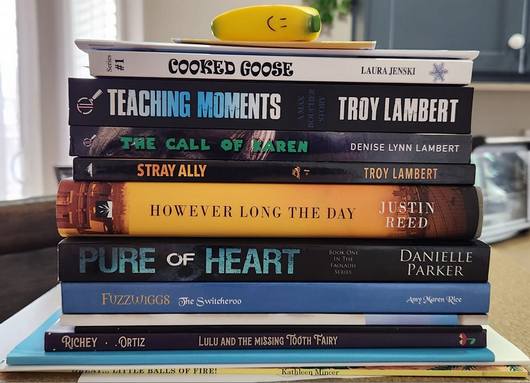Back in January, Joyce Reynolds-Ward was one of the first to participate in my Literary Locals Q&As, and I really enjoyed that. This morning I posted my take on her novel, Klone’s Stronghold (5 months after I’d hoped to). I’m pleased to welcome her back to this space to talk about her writing in particular. I focused on Klone’s Stronghold, but encouraged her to talk about her writing as a whole.
We’ve gone over your writer’s bio before, but I wanted to follow up on a couple of things. First, could you talk about your path to publication and what sparked your desire to write? Also, your bio mentions that your “work includes…(whenever possible) horses,” [in much the same way that mine would say (whenever possible) My first memory of writing was when I was about eight or nine years old, typing a fanfiction about Mighty Mouse. I don’t remember anything else about it, but a couple of years later, I started MY version of the Black Stallion story, featuring a girl and her palomino Thoroughbred mare. I’ve always told myself stories, whether they were about something I read or saw on TV, then, later, my own stories.
Horses? Well, I’m a person who has loved horses my entire life. My maternal grandfather was a chicken farmer who was a workhorse trainer on the side, specializing in rehabs and wild horses. Because he focused on workhorses, I don’t have the fancy backstory that some current horse trainers and show people do—or the connections. My old mare Mocha has been with me for eighteen years now, and I’ve learned a lot from her.
There’s also not a lot of adult-oriented stories that involve horses (Klone’s Stronghold is the rarity of my work that doesn’t have one wandering through it). The ones that do either have inaccuracies that make me want to throw the book across the room, or they focus on high-visibility equestrian sport that isn’t Western-oriented. Very little out there features normal, everyday people who ride horses and horses that are just normal, everyday horses. In the SFF realm, the only horses I’ve seen that really resemble actual equines I’ve known are either written by Judith Tarr or C.J. Cherryh (the Riders duology is absolutely perfect at tagging the twisted equine sense of humor).
Authors have dozens of ideas percolating at once (if not more), what was it about the idea that became Klone’s Stronghold that made you decide it was the one you wanted to focus on for a few months? Can you remember what nugget started that book?
Oh, this one is easy. Going over the Oregon Blue Mountains on Highway 204, there’s a little gravel road that’s labeled “Klone Lane.” I kept poking and poking at the notion of an isolated scientist doing genetic experiments in the backwoods of Northeastern Oregon, because it really did seem like an ideal location for a contemporary version of Frankenstein, The Island of Dr. Moreau, or other books of that ilk. It’s also a location for a LOT of Sasquatch sightings.
A second piece was attending multi-day outdoor music festivals at several venues in the Willamette Valley, along with the Oregon Country Fair.
Finally, I think Stronghold was intended to be my Zenna Henderson book. I really love how she folded her teaching experience into her stories and I tried to channel that mode when writing Stronghold.
Maybe this falls into the “are you a pantser or a plotter” discussion that everyone asks about, but given the elaborate—or at least widely varied—supernatural species (for lack of a better term) you have here, did you just sort of wing it and introduce ideas/races/abilities as you went along, defining them as you needed at the time—or did you work it all out in detail before hand?
I totally pantsed these supernatural species. That meant I needed to spend more time in rewrites trying to make it all fit, but it was my attempt to come up with something that wasn’t the same-old, same-old European supernatural beings transferred to the New World. It’s part and parcel with something that I’ve struggled with over the years. I don’t want to appropriate Native American beliefs even though they are more appropriate for the area where I write—they aren’t mine, I haven’t been brought up in those cultures, and coming from the settler background that I do, I believe that I need to be mindful of these things. That’s why you won’t see me writing about sknwlkrs or wndg. The cultures that those beings come from have asked that people not from their cultures avoid writing about those beings, including using their full names (therefore why I’ve disemvoweled them) so I’m trying to be respectful.
It worked in Stronghold. But I’m still wrestling with the idea in other worlds. One problem with making it all up myself is that I—have to make it all up myself. That can be daunting sometimes, especially when writing paranormal contemporary stories.
Who are some of your major influences? (whether or not you think those influences can be seen in your work—you know they’re there)
I read widely and I think that shows up in my work. I’m influenced by a lot of contemporary Western writers whose writing integrates the Western landscape into their stories. Steinbeck. Ivan Doig. Laura Pritchett (I have workshopped with her). Luis Alberto Urrea. Norman Maclean. Jamie Ford (another person I’ve workshopped with). But also, within genre—Ursula K. LeGuin. C.J. Cherryh. Aliette de Bodard. Phyllis Irene Radford. Patricia Briggs. Laura Anne Gilman. Zenna Henderson. And many others.
In our correspondence, you described Klone’s Stronghold as one of your “lesser books.” Is there anything in particular that makes you say that? Is that a verdict that you come up with later, or while writing are you thinking “this isn’t going to be my best, but let’s see how it goes anyway”?
I don’t issue that verdict in the beginning, but after I’ve put a book out. It also somewhat reflects a change in my attitude about the stories I tell, as well as how they started to become an idea.
Klone’s Stronghold is a standalone book that doesn’t seem to want to become a series. Oh, I have ideas, and notions, but nothing that coalesces sufficiently to become a story. That’s why I call it a “lesser book.” I’ve tried to make it the best book that it could be, but it doesn’t want to be anything more than that. Nothing like my Martiniere interrelated series, or the Goddess’s Honor series, or the Netwalk Sequence series. All of the first books in those series were clearly bigger than the one book, and those characters had more to say. Reeni—has pretty much said what she wants to say. She’s done with telling her story, even though there are more things that could be written about in that world. It’s also a nice little book, but it doesn’t break any new ground in storytelling. It’s not a big breakout book. It’s a story I wanted to tell.
I have another one of that ilk that’s simmering in development. Dragons of the Raven Alliance is a retelling of the colonization of North America, only with dragons as human allies. It’s one of those worlds that maybe could become a series in the hands of another writer, but for me—it’s a one-shot book that will tell a nice little story. But again, nothing big, not a breakout book. However, there’s room for the nice little stories both in my writing schedule and amongst the general public readership. Another one is my cli-fi novel, Beating the Apocalypse. Like Stronghold, it started around setting and moods, then developed into characters.
That might be the major difference. What I consider to be my big books started with characters, not setting or moods. They fit the mold of “breakout books” or “upmarket fiction” more than these books do. Because the big books are character-based, they end up becoming longer, bigger stories over several books. The setting and mood books don’t usually have sufficient impulsion within their story arc to tell anything more than the one book.
Your site lists a lot of titles—you’ve been pretty productive. What is it about storytelling/writing that keeps it fresh for you? Is this a compulsion to keep going, or is it more pleasure? Along those lines, are there genres you are still hoping to try, or are you sticking in the lanes you’ve picked? Are there genres you don’t see ever trying?
It’s pretty simple. I just like telling stories. That said, most of those books are tied into series, particularly the Martiniere books. Those characters keep coming up with more elements and pieces to tell about their world (technically, worlds, since those books are set in a multiverse).
I keep trying to venture into steampunk and Weird West. I would dearly love to write more Weird West. But. I keep running into roadblocks because I am a settler descendant and I am rabidly self-conscious about what that means and avoiding problematic stereotypes. I’m putting more romantic elements into my work, though I doubt I’d write a straightforward romance. The Martiniere books are probably the closest I’ll come to upmarket or literary fiction, though who knows? Possibilities always exist, and I do have a historical political novel simmering based on past experiences.
What you aren’t likely to see from me is a police procedural or mystery. I used to love reading that genre, but it doesn’t hold any appeal for me as either a reader or a writer these days. A non-cross-genre literary or upmarket book isn’t likely to happen. I’ve thought about writing memoirs, but they just don’t appeal. Or humor. I’m not very good at it, and I know too many people who are really, really good at humor to even give it a whirl. Or splatterpunkish stuff (now I’m dating myself!).
What’s next for Joyce Reynolds-Ward, author?
Right now I’m developing a Martiniere subseries called The Cost of Power, with book titles of Prodigal’s Return, Prodigal’s Trial, and Prodigal’s Redemption. Return is complete. Originally, it was just going to be one book but it became much more than that. Besides the usual Martiniere science fiction western with corporate soap opera, family discord, multiverse and mind control elements, I’m also adding in a fantasy element based on the legend of Melusine of Lusignan, hearkening back to events that happened during the fur trapping era of the Pacific Northwest as well as the French Wars of Religion involving Catherine di Medici. I’m hoping to release it next spring in one-month intervals—at least that’s the plan. However it turns out, it’s not going to be the Marvel Cinematic Universe, for sure!
Along with that, I’m also developing the series sequel to my first fantasy series, Goddess’s Honor, called Goddess’s Vision. The Vision series will focus on the deconstruction of the failing Darani Empire and the need for the nations of that world to unite to battle the Outcast God and the Divine Confederation. This is roughly set in a Pacific Northwest-type world—all of it, not just the wet side! And yes, it has magical horses, a breed called daranvelii.
As far as releases are concerned, my first short story collection, Fabulist and Fantastical Worlds, will be released on August 15th. Fourteen of the seventeen short stories have been previously published; the remaining three have not. I have enough published material to create several other short story collections, though some will need additions to fill them out. Those will be forthcoming.
A far future political space opera, Federation Cowboy, is now with readers and will probably come out in October. Cowboy may or may not have sequels. Like Stronghold and Apocalypse, it’s been sitting around the hard drive in one form or another for several years. I have several other ideas like that which are just waiting to take form.
Beyond that? Who knows? I might take the time to put out a collection of the ski blogs I wrote years ago. Or something further than that.
We’ll see what happens.
Thanks for your time—and thanks for Klone’s Stronghold, I loved that world and characters.
Thank you so much for your time, and I appreciate that you loved that world and characters! It did not get a great reception in the Self-Published Fantasy Blog-Off competition and really did not benefit from its entry, alas. But even though I call it one of my lesser books, I still am fond of Reeni and Strug and the kids, and I really, really like its cover. That interior needs work, so at some point I’ll reissue it, and that might be enough to stir the ol’ backbrain to whip up another story in that world. Or not. Nonetheless, it is a story I like.

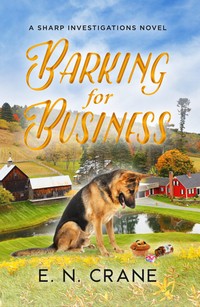 Barking for Business
Barking for Business

![]()



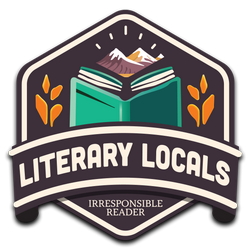

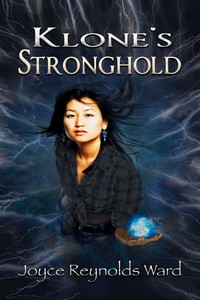

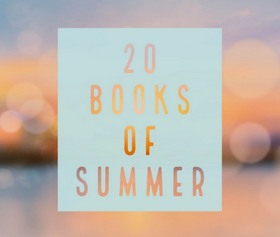
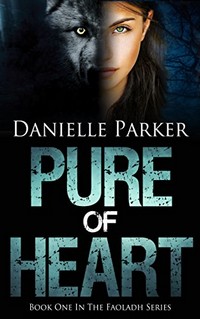
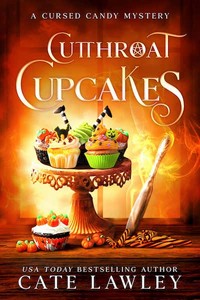
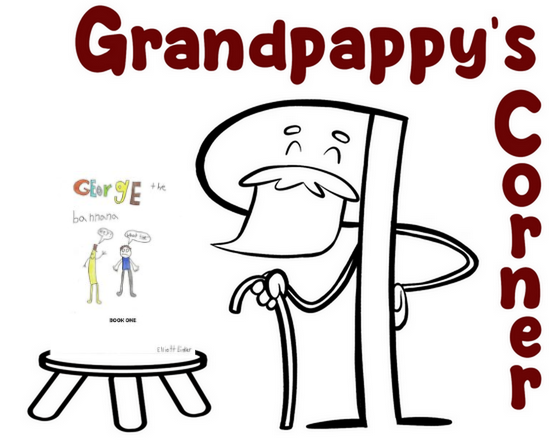
 ?)
?) 